The Incubator Analyzer Market is estimated to be valued at USD 5.5 billion in 2025 and is projected to reach USD 9.7 billion by 2035, registering a compound annual growth rate (CAGR) of 5.9% over the forecast period.
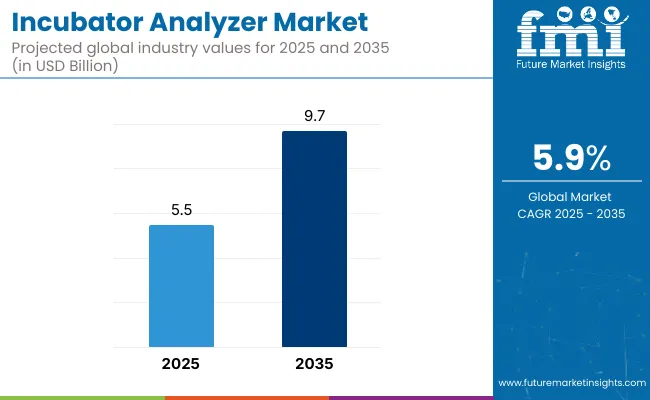
The incubator analyzer market is advancing steadily, driven by the growing need for precise environmental monitoring across various research and industrial applications. Increasing emphasis on maintaining optimal incubation conditions has elevated demand for sophisticated analyzers capable of real-time data tracking and control. Advances in sensor technologies and digital integration have enhanced analyzer performance, making them essential in quality-critical fields such as agriculture and biotechnology.
The rise in agricultural research focusing on seed germination, plant growth, and soil health monitoring has further fueled market expansion. Expansion of research facilities and laboratories equipped with advanced monitoring tools is also supporting growth.
Increasing regulatory requirements for environmental compliance in research and production processes have led to more widespread adoption of incubator analyzers. Segmental growth is expected to be led by portable incubator analyzers due to their flexibility, CO2 analyzers for their role in gas monitoring, and agriculture as the primary application sector.
The market is segmented by Modularity, Equipment Type, and Application and region. By Modularity, the market is divided into Portable Incubator Analyzer and Tabletop Incubator Analyzer. In terms of Equipment Type, the market is classified into CO2 Analyzer, Neonatal Incubator Analyzer, Universal Incubator Analyzer, and Others.
Based on Application, the market is segmented into Agriculture, Biotechnology, Industrial, and Others. Regionally, the market is classified into North America, Latin America, Western Europe, Eastern Europe, Balkan & Baltic Countries, Russia & Belarus, Central Asia, East Asia, South Asia & Pacific, and the Middle East & Africa.
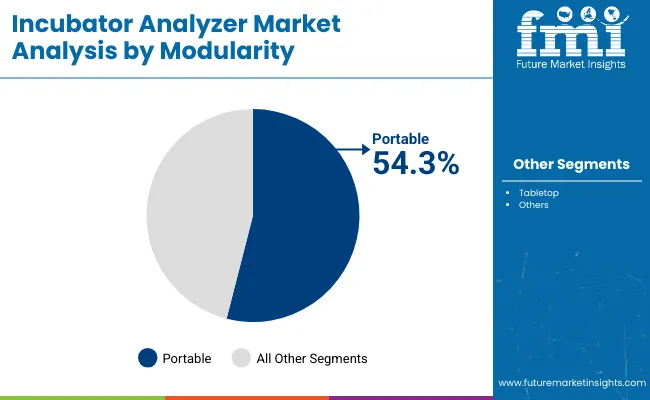
The portable incubator analyzer segment is projected to hold 54.3% of the market revenue in 2025, securing its position as the leading modularity category. This segment’s growth is driven by the demand for mobility and ease of use in diverse research environments. Portable devices offer flexibility for fieldwork and remote monitoring where stationary equipment is impractical.
The ability to quickly transport and deploy these analyzers in various locations has made them popular among researchers and agricultural professionals alike. Their compact design coupled with advanced sensing capabilities allows for real-time monitoring of incubation parameters, improving data accuracy and experimental outcomes.
The portability factor supports on-site troubleshooting and quality control, which is critical in fast-paced research and production settings. As versatility and convenience continue to influence purchasing decisions, portable incubator analyzers are expected to dominate the market.
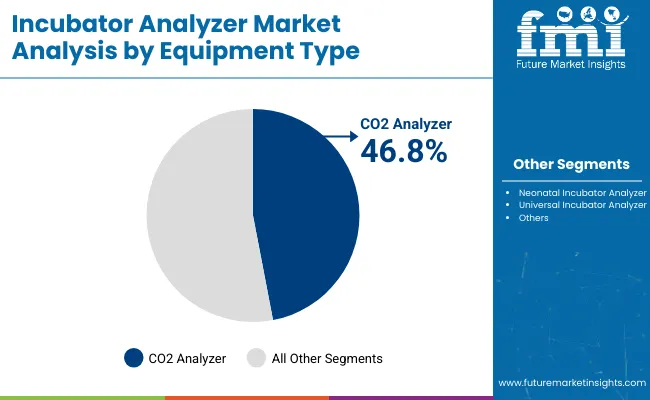
The CO2 analyzer segment is expected to contribute 46.8% of the incubator analyzer market revenue in 2025, maintaining its lead as the preferred equipment type. Monitoring CO2 levels is vital in incubation processes as CO2 concentration impacts biological growth and chemical reactions.
Precise CO2 measurement ensures the maintenance of ideal atmospheric conditions, critical for cell cultures, seed germination, and other sensitive applications. Advances in sensor accuracy and calibration have enhanced the reliability of CO2 analyzers, encouraging their adoption in both laboratory and agricultural settings.
Regulatory guidelines often mandate CO2 monitoring for environmental control, further supporting market demand. As scientific understanding of environmental factors grows, the CO2 analyzer segment will continue to play a pivotal role in ensuring incubation quality and consistency.
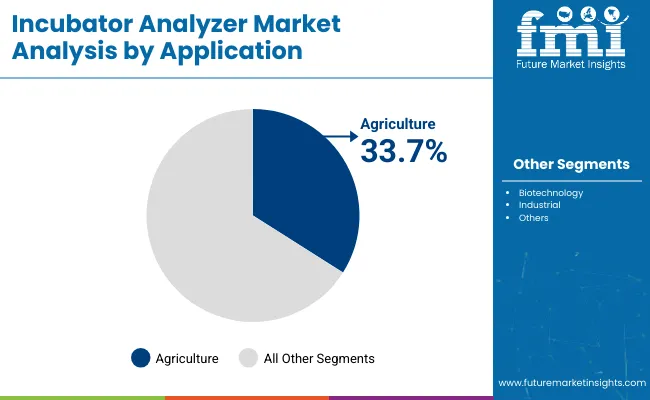
The agriculture segment is projected to represent 33.7% of the incubator analyzer market revenue in 2025, reflecting its significance as a key application area. Growth in this segment has been driven by increased agricultural research focusing on optimizing seed germination, plant propagation, and soil health under controlled conditions.
The need to improve crop yields and quality has encouraged the use of incubator analyzers to monitor critical environmental factors such as temperature, humidity, and CO2 concentration. Greenhouse operations and seed testing laboratories have particularly increased their adoption of advanced incubation monitoring systems.
Furthermore, rising global food demand and sustainability initiatives have intensified research efforts that depend on precise environmental control. The agriculture segment is expected to sustain strong growth as technological integration in farming and plant science progresses.
The low weight of babies and complications in pregnancies are anticipated to bolster the demand for incubator analyzers in the forthcoming years. As per the World Health Organization (WHO), nearly 4.1 million babies are born before the completion of 37 weeks of gestation every year. Preterm birth complications were responsible for around 1 million deaths in 204.1 and these are considered to be the leading cause of death among children belonging to the age group of 5 years and below. These numbers are anticipated to surge in the upcoming years, thereby boosting the market.
In addition to that, the rising number of neonatal intensive care units, birthing centers, and pediatric hospitals in both developed and emerging economies globally is set to fuel the growth in this market. The increasing focus of government bodies on the reduction of morbidity and mortality rates of infants is another vital factor that is projected to accelerate the market.
The high cost of infant incubators and analyzers can often restrict their usage in developing countries as not many companies have sufficient funds to adopt them. The lack of awareness and poor accessibility of neonatal care in these countries is another factor that may obstruct the global incubator analyzer market growth in future. The absence of stringent guidelines associated with the function and design of platelet incubators can also hamper the market.
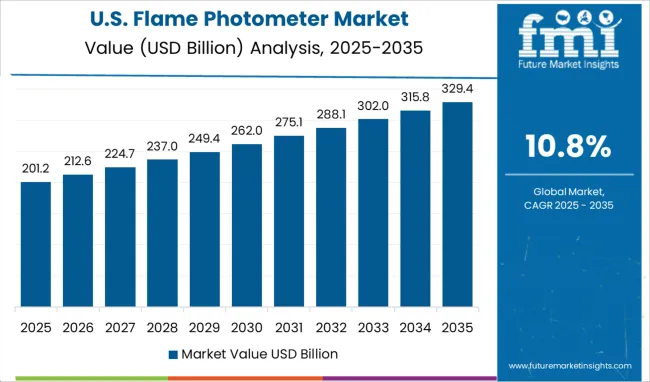
North America is estimated to remain at the forefront by accounting for the largest incubator analyzer market share in the assessment period. This growth is attributable to the easy availability of technologically advanced products in the U.S. and Canada.
The presence of numerous renowned manufacturers and a well-established healthcare infrastructure in these countries is likely to augur well for the market. According to the Centers for Disease Control and Prevention (CDC), preterm birth affected nearly 1 in 10 infants in 2024 in the U.S. alone. This number is set to increase in the future years, thereby propelling the North America market.
The increasing birth rates in emerging economies, such as India and China are estimated to accelerate the Asia Pacific incubator analyzer market growth in the evaluation period. The rising number of awareness programs conducted by government agencies to educate people regarding neonatal care is another crucial factor that is set to bolster the regional market.
The rising cases of neonatal hypothermia are anticipated to accelerate the market. The surging number of Newborn Intensive Care Unit (NICU) installations in pediatric and neonatal hospitals is another significant factor that is expected to bode well for the Asia Pacific.
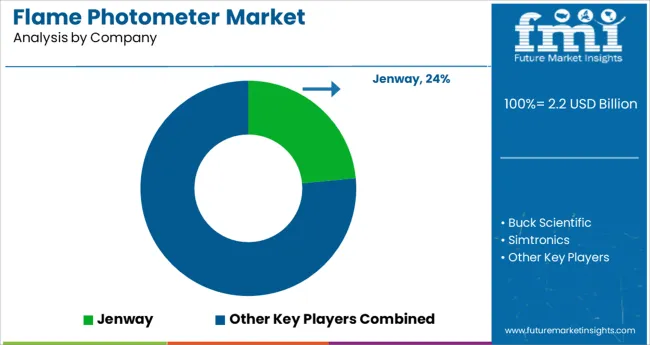
Some of the renowned companies in the global incubator analyzer market include Biodex, Fluke, Atom Medical Corporation, CIRS, General Electric, Rave Innovations, Glen Med Solutions, ERS, GAMMEX, and BioMedEquip among others.
The market is moderately competitive and houses a handful of leading players. Majority of these players are focusing on holding a substantial market share by engaging in partnerships and collaborations with local firms. Meanwhile, a few other companies are striving to develop their new production facilities in untapped areas, as well as aiming to launch innovative products to cater to the high unmet demand worldwide.
| Report Attribute | Details |
|---|---|
| Growth Rate | CAGR of 5.9% from 2025 to 2035 |
| Base Year for Estimation | 2024 |
| Historical Data | 2020 to 2024 |
| Forecast Period | 2025 to 2035 |
| Quantitative Units | Revenue in billion, Volume in Kilotons and CAGR from 2025 to 2035 |
| Report Coverage | Revenue Forecast, Volume Forecast, Company Ranking, Competitive Landscape, Growth Factors, Trends and Pricing Analysis |
| Segments Covered | Modularity, Equipment Type, Application, Region |
| Regions Covered | North America; Latin America; Western Europe; Easter Europe; APEJ; Japan; Middle East & Africa |
| Key Countries Profiled | USA, Canada, Brazil, Argentina, Germany, UK, France, Spain, Italy, Nordics, BENELUX, Australia & New Zealand, China, India, ASEAN, GCC, South Africa |
| Key Companies Profiled | Biodex; Fluke; Atom Medical Corporation; CIRS; General Electric; Rave Innovations; Glen Med Solutions; ERS; GAMMEX; BioMedEquip |
| Customization | Available Upon Request |
The global incubator analyzer market is estimated to be valued at USD 5.5 billion in 2025.
It is projected to reach USD 9.7 billion by 2035.
The market is expected to grow at a 5.9% CAGR between 2025 and 2035.
The key product types are portable incubator analyzer and tabletop incubator analyzer.
co2 analyzer segment is expected to dominate with a 46.8% industry share in 2025.






Full Research Suite comprises of:
Market outlook & trends analysis
Interviews & case studies
Strategic recommendations
Vendor profiles & capabilities analysis
5-year forecasts
8 regions and 60+ country-level data splits
Market segment data splits
12 months of continuous data updates
DELIVERED AS:
PDF EXCEL ONLINE
BOD Incubator Market Size and Share Forecast Outlook 2025 to 2035
Infant Incubators & Warmers Market Size and Share Forecast Outlook 2025 to 2035
Infant Incubators Market Analysis - Trends & Forecast 2025 to 2035
Embryo Incubator Market Growth - Trends & Forecast 2025 to 2035
Cell Culture Incubator Market Growth – Trends & Forecast 2025 to 2035
Carbon Dioxide Incubators Market Size and Share Forecast Outlook 2025 to 2035
Pharmaceutical Incubators Market
TOC Analyzer Market Size and Share Forecast Outlook 2025 to 2035
ESR Analyzer Market Analysis - Size, Share, and Forecast 2025 to 2035
XRF Analyzer Market Growth – Trends & Forecast 2019-2027
Lens Analyzer Market Size and Share Forecast Outlook 2025 to 2035
Fuel Analyzer Market
Solar Analyzer Market Size and Share Forecast Outlook 2025 to 2035
Boron Analyzer Market Size and Share Forecast Outlook 2025 to 2035
Metal Analyzers Market Size and Share Forecast Outlook 2025 to 2035
Power Analyzers Market
Logic Analyzer Market
Urine Analyzers Market
Ozone Analyzer Market
Breath Analyzer Market Size and Share Forecast Outlook 2025 to 2035

Thank you!
You will receive an email from our Business Development Manager. Please be sure to check your SPAM/JUNK folder too.
Chat With
MaRIA